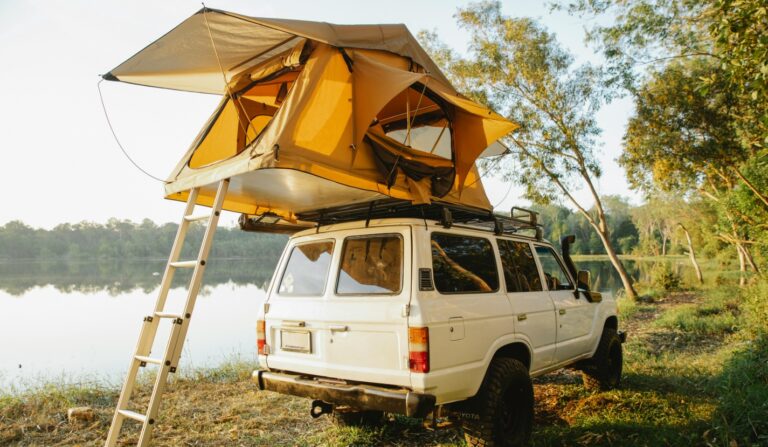
Camping is all about immersing yourself in nature, but it’s important to make sure your outdoor pursuits are environmentally friendly. By choosing sustainable camping gear and supplies, you can minimize your impact on the planet while still enjoying all the beauty and adventure of sleeping under the stars. This guide will walk you through the essential items for an eco-conscious camping kit, from solar-powered generators to biodegradable toiletries.
Harness the Sun with Portable Solar Generators
One of the biggest sustainability challenges while camping is how to power your electronic devices without relying on disposable batteries or noisy, polluting gas generators. That’s where portable solar generators come in:
- Models like the Goal Zero Yeti 400 and Jackery Explorer 500 combine high-capacity lithium batteries with efficient solar panels for clean, silent charging.
- For even more power, the EcoFlow Delta Pro and the Grid Doctor 3300 or Grid Doctor 300 solar generators have higher capacities to run things like mini fridges or CPAP machines.
- Pair your solar generator with a portable solar panel array for even faster charging, and you’ll never have to worry about running out of juice.
Not only are solar generators better for the environment than gas-powered models, they’re also safer to use in enclosed spaces like tents or RVs. And with the latest models boasting capacities of 1000 watt-hours or more, you can power everything from smartphones and cameras to portable stoves and lighting.
Choose Eco-Friendly Tents and Shelters
Your tent is your home away from home in the great outdoors, so it’s important to choose one that’s both comfortable and environmentally friendly. Some sustainable options include:
- Tents made from recycled polyester or other post-consumer materials, like the Nemo Aurora or Big Agnes Salt Creek SL.
- Shelters made from natural fibers like hemp or cotton canvas, like the Tentsile Una Tree Tent or Lotus Belle Outback Deluxe.
- Lightweight tents and tarps that pack down small to reduce fuel consumption during transport, like the Hyperlite Mountain Gear UltaMid 2 or MSR Thru-Hiker Mesh House.
Look for tents with waterproof coatings free of harmful PFCs (perfluorinated chemicals), and opt for designs with efficient ventilation to minimize the need for battery-powered fans. With proper care, a high-quality eco-friendly tent can provide many years of camping adventures.
Sleep Sustainably with Green Sleeping Bags and Pads
A warm, comfortable sleep setup is key to enjoying your time in the outdoors. Here are some eco-friendly options for sleeping bags and pads:
- Sleeping bags filled with recycled down or synthetic insulation, like the Patagonia 850 Down Sleeping Bag or the Marmot Trestles Elite Eco 20.
- Bags and quilts made from natural fibers like organic cotton or wool, like the Cotopaxi Abrazo Half-Zip Fleece Blanket or Jungmaven Hemp Sleeping Bag Liner.
- Sleeping pads made from recycled foam or post-consumer air bag materials, like the NEMO Switchback Ultralight Sleeping Pad or the Big Agnes Q-Core Deluxe Sleeping Pad.
Opt for pads and bags designed for maximum thermal efficiency to reduce the need for extra blankets or heating. And if you’re a side sleeper or tend to toss and turn, consider a thicker, more supportive sleeping pad to minimize soreness in the morning.
Pack Reusable Camp Kitchen Essentials
Preparing meals in the outdoors requires the right tools, but it doesn’t have to mean single-use plastics and disposable everything. Some must-have reusable camp kitchen items include:
- A sturdy set of plates, bowls, and utensils made from stainless steel, bamboo, or other durable materials. The UCO 4-Piece Mess Kit and To-Go Ware Bamboo Utensil Set are great options.
- Collapsible silicone food storage containers that pack down small, like the Stasher Reusable Silicone Bag or HumanGear GoBites Trio.
- Insulated tumblers or mugs for hot and cold drinks, like the Hydro Flask 12 oz Cooler Cup or the Klean Kanteen Insulated Tumbler.
- A reusable water bottle or reservoir for staying hydrated on the go. The Platypus DuoLock SoftBottle and LifeStraw Go Water Filter Bottle are durable, lightweight options.
By choosing reusable camp kitchen gear, you can significantly cut down on waste during your trip. Just remember to clean everything thoroughly before packing it away to avoid attracting critters to your campsite.
Opt for a Efficient, Eco-Friendly Camp Stove
While a crackling campfire is lovely for ambiance, camp stoves are more efficient and environmentally friendly for most of your cooking needs. Some eco-conscious options include:
- Stoves that run on renewable fuels like ethanol or biodiesel, such as the Keg FD Alcohol & Ethanol Stove or Esbit Alcohol Stove & Cookset.
- Wood-burning stoves that use small branches and twigs as fuel, like the Solo Stove Lite or the BioLite CampStove 2.
- Efficient canister stoves with adjustable flames and windscreens, like the MSR PocketRocket 2 or the Soto Windmaster.
Whichever type of stove you choose, pick one designed for maximum efficiency to minimize fuel consumption. And always follow Leave No Trace principles when cooking outdoors – pack out all your food scraps and trash, and only use downed wood for fires.
Freshen Up with Biodegradable Toiletries
Practicing good hygiene in the outdoors is important for your health and the environment. Some eco-friendly toiletry recommendations include:
- Biodegradable soap, shampoo, and toothpaste free of harsh chemicals, like the Dr. Bronner’s Pure-Castile Liquid Soap or the Redmond Earthpaste Natural Toothpaste.
- Reef-safe sunscreen without oxybenzone or octinoxate, like the Stream2Sea Sport Sunscreen or All Good SPF 30 Sport Sunscreen Lotion.
- Natural bug repellents made with essential oils, like the Natrapel Lemon Eucalyptus Insect Repellent or Repel Plant-Based Lemon Eucalyptus Insect Repellent.
- Menstrual cups or period underwear instead of single-use tampons or pads. The DivaCup and Thinx Super Hi-Waist are popular, comfortable options.
Always use toiletries at least 200 feet from water sources, and dig a cathole for solid waste. Pack out any non-biodegradable items like floss, razors, or packaging in a dedicated toiletry bag for proper disposal later.
Dress for Success with Sustainable Outdoor Apparel
The clothes and shoes you wear camping can also have an environmental impact. Some eco-friendly options include:
- Shirts, pants, and jackets made from recycled polyester or organic cotton, like the Patagonia Capilene Cool Trail Shirt or prAna Stretch Zion Pant.
- Wool socks and base layers from responsible sources like merino sheep, such as the Darn Tough Hiker Micro Crew Cushion Sock or Ridge Merino Inversion Lightweight Hoodie.
- Boots and trail running shoes with recycled components, like the Salomon Cross Hike Mid GTX or Brooks Cascadia 16.
Look for durable, high-quality apparel that will last for many camping trips. And consider shopping secondhand at outdoor gear consignment shops or online marketplaces to give pre-loved items a second life.
Leave No Trace with Other Sustainable Camping Practices
In addition to choosing eco-friendly gear, there are plenty of other ways to minimize your impact while camping:
- Plan ahead and prepare to avoid last-minute purchases of disposable items.
- Stick to designated trails and campsites to avoid trampling vegetation.
- Dispose of waste properly, packing out all trash and burying human waste in catholes.
- Leave what you find, avoiding the temptation to take natural “souvenirs” like rocks or flowers.
- Minimize campfire impacts by using existing fire rings and keeping fires small.
- Respect wildlife by observing from a distance and properly storing food.
- Be considerate of other visitors by keeping noise to a minimum and protecting the quality of their experience.
By following the seven principles of Leave No Trace, you can help protect the outdoor spaces you love for generations to come. Remember, the goal is to leave your campsite in better condition than you found it.
Key Takeaways for Building a Sustainable Camping Kit
As you gear up for your next eco-friendly camping trip, keep these tips in mind:
- Invest in a portable solar generator and solar panel array for clean, silent power. Models like the Jackery Explorer 500 and the Grid Doctor 3300 are great options.
- Choose a tent made from recycled or natural materials, with PFC-free waterproofing and efficient ventilation.
- Sleep sustainably with a recycled down or organic cotton sleeping bag and recycled foam sleeping pad.
- Pack reusable camp kitchen essentials like utensils, food storage containers, and water bottles to minimize single-use plastics.
- Opt for an efficient camp stove that runs on renewable fuel or uses small amounts of wood.
- Freshen up with biodegradable toiletries like organic toothpaste, reef-safe sunscreen, and a menstrual cup.
- Dress for the elements in apparel made from recycled or organic materials, like merino wool socks and a recycled polyester rain jacket.
With a little extra thought and preparation, you can build a camping kit that’s not only functional and comfortable, but also kind to the planet. By voting with your wallet for sustainable outdoor gear, you can help drive the industry towards greener practices and protect the wild places you love.






